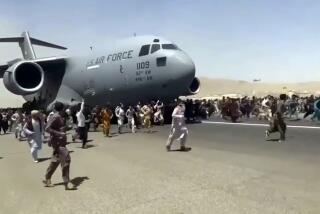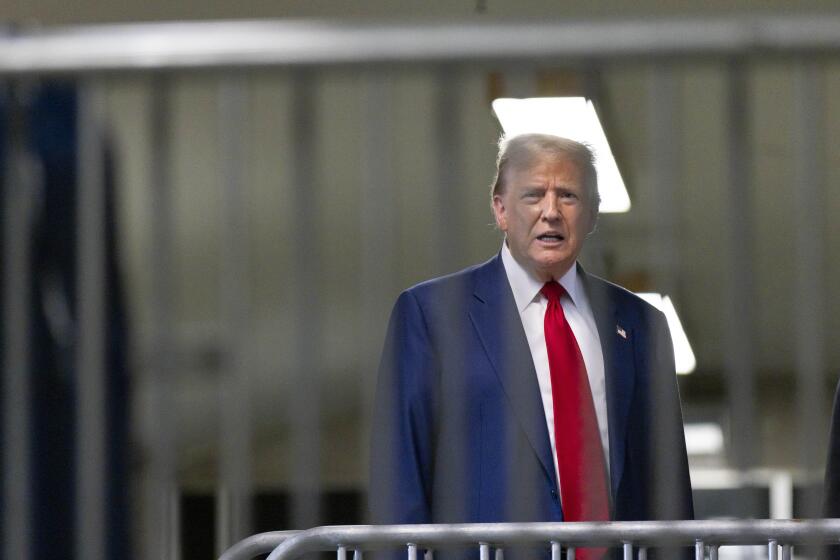Column: Trump wants to leave Syria. Easier said than done

When President Trump abruptly announced on Dec. 19 that he was pulling all U.S. troops out of Syria, he suggested they were already on the way home.
“We have won against ISIS,” the president said, referring to Islamic State. “Our boys, our young women, our men — they’re all coming back, and they’re coming back now.”
His “now” was premature. More than a month later, the 2,000 or so U.S. military personnel remain in eastern Syria and administration policy remains as much a muddle as ever.
American diplomats are still haggling with Turkey over the conditions under which U.S. troops will come out, and the Pentagon has announced no timeline for their removal.
The holdup isn’t merely logistical. Like it or not — and the president often sounds as if he doesn’t — the United States still has significant interests in Syria.
Despite Trump’s claim, Islamic State appears stubbornly alive, if not well. Its militants have launched two suicide attacks against U.S. troops in the last week, one of which killed four Americans.
Iran, which Trump considers a malevolent enemy, has moved thousands of forces into Syria and could try to grab territory abandoned by U.S. troops as it seeks to further its influence.
The latest war within a war, between Iran and Israel, has now escalated sharply. On Monday, Israeli Prime Minister Benjamin Netanyahu said his air force had struck Iranian-linked targets in Syria “hundreds of times.”
Trump’s initial order to remove U.S. troops was impulsive at best, taking senior aides by surprise and without any evident support from the Pentagon or his national security team.
Indeed, his decision prompted Defense Secretary James N. Mattis to resign in protest due, in part, to concerns that Turkey would use the U.S. pullout to slaughter Kurdish fighters who have been stalwart American allies but oppose the regime in Ankara.
“There’s no plan for what’s coming next,” Brett McGurk, the former U.S. diplomat who ran the coalition against Islamic State but also resigned early over the Syria decision, complained Sunday on CBS’ “Face the Nation.”
Aides have scrambled to persuade the president that an orderly withdrawal of 2,000 troops and their equipment will require more than 30 days, and they appear to have succeeded. By all reports, only a few vehicles have decamped.
“I never said we are doing it that quickly,” Trump said on Jan. 6, or 18 days after he said they were “coming back now.”
But the president and his advisors still haven’t solved a more complex problem: finding a post-withdrawal strategy that protects U.S. interests. So far, administration officials merely say they will pursue the same goals by working through allies.
It’s hard to see that as a blueprint for success.
In a recent speech in Cairo, Secretary of State Michael R. Pompeo said U.S. forces would continue to fight Islamic State with U.S. and coalition airstrikes, but on the ground “we’re looking for our partners to do more.”
U.S. officials long have pleaded with Saudi Arabia and other Arab allies to deploy a multinational force in Syria, to no avail. There is no capable ground force available.
Organizing a new military coalition “takes American leadership and takes American presence — and we’ve just told the world that we’re not going to be present,” McGurk said.
In his Cairo speech, Pompeo reaffirmed another ambitious goal, saying the administration intended “to expel every last Iranian boot” from Syria.
In Pompeo’s formulation, the Trump administration will push the Iranians out through diplomatic pressure and work with the United Nations — a body Trump has regularly scorned — “to bring peace and stability to the long-suffering Syrian people.”
If President Obama had said that three years ago, then-Rep. Pompeo would have dismissed it as meaningless rhetoric.
Still, when it comes to Iran’s presence, the Trump administration has the next best thing to a strategy: the Israeli air force.
Netanyahu and Israeli military leaders decided more than a year ago that Iran’s forces posed a threat on their northern border, and they escalated airstrikes against Iranian military units there. Until then, Israeli warplanes had targeted Hezbollah, the Iran-backed Lebanese militia, but mostly avoided Iranian forces.
Now Israeli officials are publicizing their military offensive in a clear message to Tehran. “Don’t get the idea you can move in just because the Americans are moving out,” a foreign policy expert in Jerusalem explained.
That’s not quite expelling every Iranian boot, but it’s more concrete than what the White House has offered.
Let’s be clear. There’s nothing inherently wrong with pulling U.S. troops out of Syria as long as it’s part of a well-crafted strategy. Obama reluctantly deployed troops in 2015 and planned to keep them in Syria only long enough to defeat Islamic State. On that count, Trump agreed.
The question bedeviling the Trump administration is how to continue pursuing American interests in Syria — the suppression of terrorism and the containment of Iran — after complying with the president’s order to leave.
Better to settle on more plausible goals and recognize that the United States will still be engaged in a long twilight war in Syria — even after our troops are gone.
More to Read
Get the L.A. Times Politics newsletter
Deeply reported insights into legislation, politics and policy from Sacramento, Washington and beyond. In your inbox three times per week.
You may occasionally receive promotional content from the Los Angeles Times.







